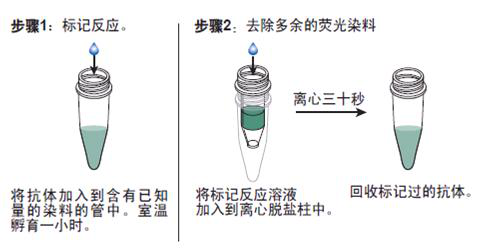
|

| 产地 | 进口、国产 |
| 品牌 | 上海莼试 |
| 保存条件 | Store at -20 °C |
| 货号 | CS12290 |
| 应用范围 | WB=1:100-500 ELISA=1:500-1000 IP=1:20-100 IHC-P=1:100-500 IHC-F=1:100-500 IF=1:100-500 |
| CAS编号 | |
| 抗体名 | Anti-SRPK2 |
| 克隆性 | 是 |
| 靶点 | 详见说明书 |
| 适应物种 | 详见说明书 |
| 形态 | 详见说明书 |
| 宿主 | 详见说明书 |
| 亚型 | IgG |
| 标识物 | 详见说明书 |
| 浓度 | 1mg/1ml% |
| 免疫原 | KLH conjugated synthetic peptide derived from human SRPK2 |
产品订购信息:
英文名称 Anti-SRPK2
中文名称 丝氨酸/苏氨酸蛋白激酶SRPK2抗体规格
别 名 Human serine kinase SRPK2 mRNA, complete cds; Serine kinase SRPK2; Serine/arginine rich protein specific kinase 2; Serine/threonine protein kinase SRPK2; SFRS protein kinase 2; SFRSK2; SR protein specific kinase 2; SRPK2_HUMAN.


浓 度 1mg/1ml
规 格 0.2ml/200μg
抗体来源 Rabbit
克隆类型 polyclonal
交叉反应 Human, Mouse, Rat, Chicken, Dog, Pig, Cow, Horse, Rabbit, Sheep
产品类型 一抗
研究领域 细胞生物 信号转导 细胞周期蛋白 激酶和磷酸酶 表观遗传学
蛋白分子量 predicted molecular weight: 77kDa
性 状 Lyophilized or Liquid
免 疫 原 KLH conjugated synthetic peptide derived from human SRPK2
亚 型 IgG
纯化方法 affinity purified by Protein A
储 存 液 Preservative: 15mM Sodium Azide, Constituents: 1% BSA, 0.01M PBS, pH 7.4
丝氨酸/苏氨酸蛋白激酶SRPK2抗体规格 产品应用 WB=1:100-500 ELISA=1:500-1000 IP=1:20-100 IHC-P=1:100-500 IHC-F=1:100-500 IF=1:100-500
(石蜡切片需做抗原修复)
not yet tested in other applications.
optimal dilutions/concentrations should be determined by the end user.
保存条件 Store at -20 °C for one year. Avoid repeated freeze/thaw cycles. The lyophilized antibody is stable at room temperature for at least one month and for greater than a year when kept at -20°C. When reconstituted in sterile pH 7.4 0.01M PBS or diluent of antibody the antibody is stable for at least two weeks at 2-4 °C.
Important Note This product as supplied is intended for research use only, not for use in human, therapeutic or diagnostic applications.
产品介绍 SRPK2 belongs to the protein kinase superfamily. It phosphorylates RS domain-containing proteins, such as SFRS1 and SFRS2 on serine residues. It has a role in spliceosome assembly and in mediating the trafficking of splicing factors and appears to mediate HBV core protein phosphorylation which is a prerequisite for pregenomic RNA encapsidation into viral capsids. SRPK2 highly expressed in brain, moderately expressed in heart and skeletal muscle and at low levels in lung, liver, and kidney.
Function : Serine/arginine-rich protein-specific kinase which specifically phosphorylates its substrates at serine residues located in regions rich in arginine/serine dipeptides, known as RS domains and is involved in the phosphorylation of SR splicing factors and the regulation of splicing. Promotes neuronal apoptosis by up-regulating cyclin-D1 (CCND1) expression. This is done by the phosphorylation of SRSF2, leading to the suppression of p53/TP53 phosphorylation thereby relieving the repressive effect of p53/TP53 on cyclin-D1 (CCND1) expression. Phosphorylates ACIN1, and redistributes it from the nuclear speckles to the nucleoplasm, resulting in cyclin A1 but not cyclin A2 up-regulation. Plays an essential role in splicesomal B complex formation via the phosphorylation of DDX23/PRP28. Can mediate hepatitis B virus (HBV) core protein phosphorylation. Plays a negative role in the regulation of HBV replication through a mechanism not involving the phosphorylation of the core protein but by reducing the packaging efficiency of the pregenomic RNA (pgRNA) without affecting the formation of the viral core particles.
Subunit : Interacts with PKB/AKT1 in a phosphorylation-dependent manner. The phosphorylated form (by PKB/AKT1) interacts with YWHAB and YWHAE. Interaction with YWHAB suppresses its cleavage by caspases and inhibits the release of its N-terminal pro-apoptotic fragment. Interacts with SFN. Associates with U4/U6-U5 tri-small nuclear ribonucleoproteins (U4/U6-U5 tri-snRNPs).
Subcellular Location : Cytoplasm. Nucleus. Note=Shuttles between the nucleus and the cytoplasm. KAT5/TIP60 inhibits its nuclear translocation. Phosphorylation at Thr-492 by PKB/AKT1 promotes nuclear translocation.
Tissue Specificity : Highly expressed in brain, moderately expressed in heart and skeletal muscle and at low levels in lung, liver, and kidney.
Post-translational modifications : Proteolytically cleaved at Asp-139 and Asp-403 by caspase-3 during apoptotic cell death. Cleavage at Asp-139 which is the major site of cleavage, produces a small N-terminal fragment that translocates into nucleus and promotes VP16-induced apoptosis.
Similarity : Phosphorylation at Thr-492 by PKB/AKT1 enhances its stimulatory activity in triggering cyclin-D1 (CCND1) expression and promoting apoptosis in neurons, which can be blocked by YWHAB. It also enhances its protein kinase activity toward ACIN1 and SRSF2, promotes its nuclear translocation and prevents its proteolytic cleavage.
Belongs to the protein kinase superfamily. CMGC Ser/Thr protein kinase family.
Contains 1 protein kinase domain.
Database links : UniProtKB/Swiss-Prot: P78362.3

紧密连接蛋白3 多克隆抗体 ZO3 Polyclonal Antibody 700/30ul#1540/100ul#2520/200ul
丝氨酸蛋白酶抑制剂A10 多克隆抗体 ZPI Polyclonal Antibody 700/30ul#1540/100ul#2520/200ul
锌指蛋白206 多克隆抗体 ZSC10 Polyclonal Antibody 700/30ul#1540/100ul#2520/200ul
锌指蛋白854 多克隆抗体 ZSCA2 Polyclonal Antibody 700/30ul#1540/100ul#2520/200ul
B-2 单克隆抗体 Bcl-2 Monoclonal Antibody 700/30ul#1540/100ul#2520/200ul
莱姆病螺旋体抗体 有丝分裂相关蛋白INSC抗体
成熟相关蛋白BOULE抗体 有丝分裂细胞周期蛋白MPP9抗体
伸长因子结合蛋白抗体 有丝分裂驱动蛋白样2抗体
特异性碱性蛋白Y2抗体 有丝分裂驱动蛋白样2B抗体
易感基因2相关蛋白抗体 有丝分裂驱动蛋白样1抗体
锌指蛋白20D3抗体 24脱氢胆固醇还原酶抗体
锌指蛋白804A抗体 22号染色体开放阅读框9抗体
负调控因子白细胞介素2抗体 22号染色体开放阅读框45抗体
锌指蛋白BED3抗体 22号染色体开放阅读框43抗体
锌指蛋白379抗体 22号染色体开放阅读框40抗体
羽叶白头树Garuga pinnata Reynorin 槲皮素-3-D-木糖甙 549-32-6 C20H18O11 ≥95%
蟾毒灵BufclinHPLC≥98%,20mg/支
(R型)人参皂苷Rg3 20(R)Ginsenoside Rg3 20mg HPLC≥98% 用于含量测定
中药对照药材地耳草121468-200401TLC法鉴别
Sweroside獐芽菜苷纯度:98%
丝氨酸/苏氨酸蛋白激酶SRPK2抗体规格光叶巴豆Croton laevigatus Taraxerone 蒲公英赛酮 514-07-8 C30H48O ≥98.5%
远华蟾蜍精Tqlocinobufcgin1947-6-420mg
莲心减 Liensinine 2586-96-1 20mg HPLC≥98% 用于含量测定
含量测定醋谷胺100859-200501常温,避光100mg
5-去甲川陈皮素 5-Demetxylnobiletin 2174-59-6 20mg HPLC≥98% 5-去甲川陈皮素 2174-59-6

抗体的生物素化标记实验要点:
1. 丝氨酸/苏氨酸蛋白激酶SRPK2抗体规格 如在反应混合液中有叠氮钠或游离氨基存在,会抑制标记反应。因此,蛋白质在反应前要对 0.1mol/L碳酸氢钠缓冲液或0.5mol/L硼酸缓冲液充分透析;
2.所用的NHSB及待生物素化蛋白质之间的分子比按蛋白质表面的ε-氨基的密度会有所不同,选择不当则影响标记的效率,应先用几个不同的分子比来筛选最适条件;
3.用NHSB量过量也是不利的,抗原的结合位点可能因此被封闭,导致抗体失活;
4.由于抗体的氨基不易接近可能造成生物素化不足,此时可加入去污剂如 Triton x-100, Tween20等;
5.当游离ε-氨基(赖氨酸残基的氨基)存在于抗体的抗原结合位点时,或位于酶的催化位点时,生物素化会降低或损伤抗体蛋白的结合力或活性;
6.生物素还可能与不同的功能基团,如羰基、氨基、巯基、异咪唑基及苯酚基,也可与糖基共价结合;
7.交联反应后,应充分透析,否则,残余的生物素会对生物素化抗体与亲和素的结合产生竞争作用;
8.在细胞的荧光标记实验中,中和亲和素的本底低,但由于链霉亲和素含有少量正电荷,故对某些细胞可导致高本底。
抗体的鉴定:
1)丝氨酸/苏氨酸蛋白激酶SRPK2抗体规格 抗体的效价鉴定:不管是用于诊断还是用于,制备抗体的目的都是要求较高效价。不同的抗原制备的抗体,要求的效价不一。鉴定效价的方法很多,包括有试管凝集反应,琼脂扩散试验,酶联免疫吸附试验等。常用的抗原所制备的抗体一般都有约成的鉴定效价的方法,以资比较。如制备抗抗体的效价,一般就采用琼脂扩散试验来鉴定。
2)抗体的特异性鉴定:抗体的特异性是指与相应抗原或近似抗原物质的识别能力。抗体的特异性高,它的识别能力就强。衡量特异性通常以交叉反应率来表示。交叉反应率可用竞争抑制试验测定。以不同浓度抗原和近似抗原分别做竞争抑制曲线,计算各自的结合率,求出各自在IC50时的浓度,并按公式计算交叉反应率。
如果所用抗原浓度IC50浓度为pg/管,而一些近似抗原物质的IC50浓度几乎是无穷大时,表示这一抗血清与其他抗原物质的交叉反应率近似为0,即该血清的特异性较好。
3)抗体亲和力:是指抗体和抗原结合的牢固程度。亲和力的高低是由抗原分子的大小,抗体分子的结合位点与抗原决定簇之间立体构型的合适度决定的。有助于维持抗原抗体复合物稳定的分子间力有氢键,疏水键,侧链相反电荷基因的库仑力,范德华力和空间斥力。亲和力常以亲和常数K表示,K的单位是L/mol。抗体亲和力的测定对抗体的筛选,确定抗体的用途,验证抗体的均一性等均有重要意义。